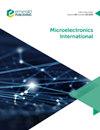Real-time contact angle’s measurement of molten solder balls in laboratory conditions
IF 0.8
4区 工程技术
Q4 ENGINEERING, ELECTRICAL & ELECTRONIC
引用次数: 1
Abstract
Purpose The purpose of this paper is to show a possibility to measure a change of a contact angle during the melting in real-time and to reveal significant factors of a wettability. Influence of the flux with combination of plasma on copper surface was investigated in experiment as well. Design/methodology/approach Laboratory equipment consists of heating and optical part that was developed and tested for real-time contact angle’s measurements. Solder balls based on Sn96.5/Ag3/Cu0.5 and Sn63Pb37 spread out on a copper substrate during a melting process. The wettability of pure copper surface was compared with copper surface treated with flux or combination plasma–flux. The contact angle and spreading rate of a melted solder balls observed by the charged-coupled device camera were analyzed in real-time and measured using the JavaScript. Findings Laboratory equipment allows for analysis of contact angle and spreading rate in real-time during the melting process. The contact angle decreases more noticeable after applying the plasma-flux treatment in contrast to no flux or flux treatment only. Using the plasma treatment before application of the flux improves the wettability and the effectivity of the flux activity on the copper surface during the melting process. Originality/value The interpretation of the results of such a comprehensive measurement leads to a better understanding of the mutual relation between flux and combination plasma–flux of the wetting during the melting process. The simple, cheap, fast and accurate laboratory equipment, which consists of the heating and the optical part, allows for the wettability evaluation of the melting process in real-time.实验室条件下熔融焊锡球接触角的实时测量
目的本文的目的是展示一种实时测量熔融过程中接触角变化的可能性,并揭示润湿性的重要因素。实验中还考察了等离子体结合对铜表面的影响。设计/方法/方法实验室设备由加热和光学部件组成,这些部件是为实时接触角测量而开发和测试的。在熔化过程中,基于Sn96.5/Ag3/Cu0.5和Sn63Pb37的焊球在铜衬底上展开。将纯铜表面的润湿性与用助熔剂或组合等离子体-助熔剂处理的铜表面进行了比较。通过带电耦合设备相机观察到的熔化焊球的接触角和扩展速率被实时分析,并使用JavaScript.FindingsLaboratory设备可以在熔化过程中实时分析接触角和扩散速率。与无通量或仅通量处理相比,在应用等离子体通量处理之后,接触角减小得更加明显。在使用助熔剂之前使用等离子体处理提高了熔融过程中助熔剂在铜表面的润湿性和活性的有效性。独创性/价值对这种综合测量结果的解释有助于更好地理解熔化过程中润湿的通量和组合等离子体通量之间的相互关系。由加热和光学部分组成的简单、廉价、快速、准确的实验室设备可以实时评估熔融过程的润湿性。
本文章由计算机程序翻译,如有差异,请以英文原文为准。
求助全文
约1分钟内获得全文
求助全文
来源期刊

Microelectronics International
工程技术-材料科学:综合
CiteScore
1.90
自引率
9.10%
发文量
28
审稿时长
>12 weeks
期刊介绍:
Microelectronics International provides an authoritative, international and independent forum for the critical evaluation and dissemination of research and development, applications, processes and current practices relating to advanced packaging, micro-circuit engineering, interconnection, semiconductor technology and systems engineering. It represents a current, comprehensive and practical information tool. The Editor, Dr John Atkinson, welcomes contributions to the journal including technical papers, research papers, case studies and review papers for publication. Please view the Author Guidelines for further details.
Microelectronics International comprises a multi-disciplinary study of the key technologies and related issues associated with the design, manufacture, assembly and various applications of miniaturized electronic devices and advanced packages. Among the broad range of topics covered are:
• Advanced packaging
• Ceramics
• Chip attachment
• Chip on board (COB)
• Chip scale packaging
• Flexible substrates
• MEMS
• Micro-circuit technology
• Microelectronic materials
• Multichip modules (MCMs)
• Organic/polymer electronics
• Printed electronics
• Semiconductor technology
• Solid state sensors
• Thermal management
• Thick/thin film technology
• Wafer scale processing.
 求助内容:
求助内容: 应助结果提醒方式:
应助结果提醒方式:


